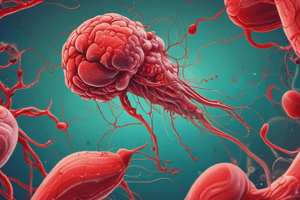Podcast
Questions and Answers
Which of the following describes the main function of hemostasis?
Which of the following describes the main function of hemostasis?
- To maintain blood in a fluid state within the circulatory system and stop bleeding after vascular injury. (correct)
- To accelerate blood flow to promote oxygen delivery to tissues.
- To increase blood viscosity and slow down circulation.
- To decrease the production of blood cells in response to injury.
Which of the following is NOT a primary function of haemostatic mechanisms?
Which of the following is NOT a primary function of haemostatic mechanisms?
- Preventing blood loss from intact blood vessels.
- Promoting vasoconstriction in uninjured vessels to maintain blood pressure. (correct)
- Ensuring the removal of the blood clot after healing is complete.
- Stopping excessive bleeding from injured blood vessels.
What is the main process that occurs during secondary hemostasis?
What is the main process that occurs during secondary hemostasis?
- Formation of a platelet plug due to platelet aggregation and adhesion.
- Breakdown of the fibrin clot by plasmin to restore normal blood flow.
- Formation of fibrin through the coagulation cascade to reinforce the platelet plug. (correct)
- Activation of vasoconstriction to reduce blood flow to the injured area.
Which of the following is the FIRST event that occurs during primary hemostasis?
Which of the following is the FIRST event that occurs during primary hemostasis?
What is the role of thrombocytes in primary hemostasis?
What is the role of thrombocytes in primary hemostasis?
Which of the following best describes the role of tissue factor in secondary hemostasis?
Which of the following best describes the role of tissue factor in secondary hemostasis?
In the context of coagulation, what is the 'common pathway'?
In the context of coagulation, what is the 'common pathway'?
What is the primary function of tertiary hemostasis?
What is the primary function of tertiary hemostasis?
Flashcards
Primary Hemostasis
Primary Hemostasis
Formation of a platelet plug with vasoconstriction to stop bleeding.
Hemostasis
Hemostasis
The process keeping blood fluid while stopping bleeding after injury.
Vasoconstriction
Vasoconstriction
Narrowing of blood vessels to reduce blood flow at injury site.
Platelet Plug
Platelet Plug
Temporary blockage formed by platelets to arrest bleeding.
Signup and view all the flashcards
Secondary Hemostasis
Secondary Hemostasis
Formation of fibrin through the coagulation cascade after primary hemostasis.
Signup and view all the flashcards
Fibrin
Fibrin
A protein that forms a mesh to solidify the blood clot during secondary hemostasis.
Signup and view all the flashcards
Tertiary Hemostasis
Tertiary Hemostasis
Final phase where plasmin breaks down the clot allowing healing.
Signup and view all the flashcards
Fibrinolysis
Fibrinolysis
The breakdown of fibrin in clots, completed within 48-72 hours.
Signup and view all the flashcardsStudy Notes
Overview of Hemostasis and Coagulation
- Hemostasis is a process responsible for keeping blood in a fluid state within the circulatory system and stopping bleeding after blood vessel injury.
Definition of Hemostasis
- Hemostasis is a vital process for maintaining blood's fluid state within the circulatory system and for stopping bleeding after injury to blood vessels.
Hemostasis (Physiology)
- The function of haemostatic mechanisms is threefold: preventing blood loss from undamaged vessels, stopping excessive bleeding from injured vessels, and ensuring the removal of the blood clot once healing is complete.
Steps of Hemostasis
- Hemostasis is divided into three key phases:
- Primary hemostasis: Formation of platelet plug through vasoconstriction.
- Secondary hemostasis: Formation of fibrin through the coagulation cascade.
- Tertiary hemostasis: Formation of plasmin to break down the clot.
Primary Hemostasis
- Blood vessel phase: Blood vessels constrict, reducing blood flow to the injured area. Tissue or exogenous factors are released.
- Platelet phase: Platelets adhere to the damaged site, aggregate, and release factors, forming a platelet plug.
- This phase results in a temporary arrest of bleeding, typically within 3-5 minutes.
Primary Hemostasis (Detailed)
- Platelet adhesion: Platelets adhere to exposed collagen in damaged blood vessels.
- Shape change: Platelets change shape, becoming activated.
- Granule release: Platelets release substances like ADP and TXA2.
- Recruitment: Further platelets are recruited to the site of injury causing aggregation.
Secondary Hemostasis
- Plasma coagulation factors: These factors activate the coagulation cascade, leading to the formation of fibrin which strengthens the platelet plug.
- Tissue factor: Plays a crucial role in triggering the extrinsic pathway in the coagulation cascade.
- This phase takes 5-10 minutes, strengthening the platelet plug and arresting bleeding definitively.
Secondary Hemostasis (Detail)
- Fibrin formation: Activated clotting factors (protein cascade) cause fibrin to polymerize, creating a mesh-like structure that reinforces the platelet plug.
- Phospholipid complex: This complex supports efficient activation of coagulation factors.
- Thrombin activation: Thrombin catalyzes the conversion of fibrinogen to fibrin polymers.
Plasma Coagulation Factors
- The coagulation process is controlled by various factors categorized into three main pathways:
- Intrinsic pathway: Initiated by injury within the vascular endothelium.
- Extrinsic pathway: Initiated by external injuries such as tissue damage.
- Common pathway: A shared pathway resulting in the activation for the common protein activation needed to generate blood clots.
Coagulation Pathways (Details)
The image shows a detailed illustration of the various coagulation factors, their interactions, and the pathways involved in clot formation. Specific factors (e.g., XII, XI, IX, VIII, X, V, II) and their actions are illustrated.
Tertiary Hemostasis
- Fibrinolysis: Plasmin, an enzyme, breaks down the fibrin clot, enabling the healing process and the return of the vessel to normal function.
- This step starts 48-72 hours after the injury.
Summary of Phases
- The visual aids/diagrams shows the vascular, platelet, coagulation, clot retraction, and clot destruction processes involved in the hemostasis.
Studying That Suits You
Use AI to generate personalized quizzes and flashcards to suit your learning preferences.




